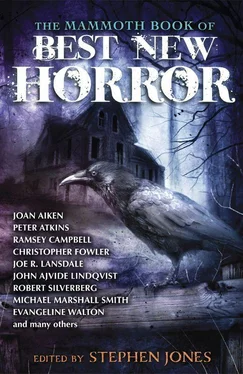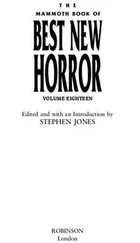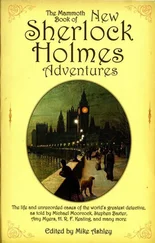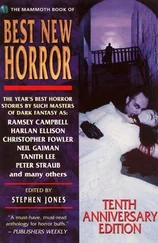I had, of course, seen the same view innumerable times before, and it was quite familiar to me. But this time, from the profusion of the mist, there appeared this fantastic new structure, as if risen up from inconceivable depths; with one lone Tower breaking the waves and the tolling of immense bells heralding the return of an Atlantean cathedral wreathed in sea-fog.
In design the Tower was fantastically lofty, a dizzying physical projection capable of being conceived only in the mind of an individual given over wholly to dream. It radiated an aura of antiquity, and the surface of its brickwork was thick with the grey dust of untold centuries. The titanic spire that formed its pinnacle was bewildering to the imagination, for its height surpassed any of the skyscrapers of the “triumphant” modern era. It was as if the Tower was the spectre of a structure that had been destroyed, but which had forced its way back into existence, or back into human consciousness, which — nevertheless — amounts to the same thing.
The appearance, overnight, of a structural invader amidst the architectural vista to which one has become accustomed, seen from one’s own window, provokes terror.
Doubtless some puerile Freudian analyst would have had the temerity to designate the appearance of the Tower as evidence of a phallic symbol erupting into my consciousness from the depths of repression, but, in opposition to such a notion, one that cannot be disproved since its basis is ideological, I can do little more save express my scorn and contempt. The anthropodeist perspective is so ingrained into modern man that to the absolutely convinced any attempt at denial contains the seeds of its own defeat. Unable to acquiesce, I felt to protest the thesis was to confirm it.
By the time I had rapidly dressed and was ready to venture out into the mist, it had lifted and when next I looked out of the window, the Tower had vanished utterly.
I cursed myself for a fool and a victim of my own imaginings, for I have always been a dreamer, and such a one is often prone to delusion.
I could not help but conclude that the Tower could be seen only when the mist was present, and was not merely the by-product of my own mind having become disordered. This I realised over the course of many weeks observation, seeking in vain for the elusive structure. It was not a phantom edifice conjured by a mental fugue. Its first appearance occurred moments after I had awoken for the day, had lit a cigarette and sat absent-mindedly in my easy chair looking out the window, with a completely clear frame of reference. Since my rooms (which I had occupied for just over a month) are on the third floor a quarter of the way up the steep rise of this district’s hill, the view is extensive and I can see over huddled rooftops all the way to the summit.
If only it were not the case that the noise of tolling bells in the Tower had been so ghostly, more like the shadow of a sound than a sound itself, then I could have hoped others might notice, but it could be heard only late at night, at those moments when the world is at its quietest, when conversations die, when broadcasts and recordings are turned off, when dreams replace thoughts. And then there was the anti-light therein, not darkness, but of a negative intensity that, though glimpsed only through the Tower’s narrow, gaunt apertures, formed streaming shafts of an unknown colour, and penetrated the gloom of the mist that lay without like mystical searchlights.
Though I tried not to allow this vision to dominate my day-today life, I could not resist its allure. Only when a mist descended was the Tower visible. I became a devotee of its capricious nature and longed, like a spurned lover, to further what opportunities were available for me to glimpse again the half-ruined edifice from which strange, distant chants seemed eventually to mingle with the tolling bells and whose warped architecture told a tale of madness beyond the apprehension of those who went about their commonplace lives.
I alone knew that some ultimate mystery was to be found within, and only inside the immense confines of the apparition would I discover the symbol for which the Tower stood. I was prepared always for the advent of mist, whether in the early morning or during the midnight hours, and went abroad in pursuit of the titanic structure, wandering the streets in a desperate attempt to get closer and closer. Yet, despite my best endeavours, I found it impossible to draw near, for the Tower seemed to maintain a fixed distance, one unrelated to my own conceptions of proximity.
It was, of course, not a physical, but rather a spiritual , phenomenon. The matter of my approach depended less on my physical route and the speed with which I acted, than upon my own state of mind. The Tower was not a structure visible to all, for it appeared only to those who had been initiated into its mysteries. I dared not speak of it to anyone else, lest the spell be broken by my own faithlessness, and the mystery be snatched away from me.
I wondered then whether the fog, too, existed in my own mind, and formed as much a part of the initiatory sequence as any other component of the process of transformation.
True, I had been drinking a great deal. True also, that the small capital upon which I had been drawing in order to keep me from ruin, was close to exhaustion. My attempts to connect with the so-called “real world” had been unsuccessful. My rent was several weeks in arrears. What food I could afford to purchase was of the cheapest and least nutritious kind: instant noodles, bread on the last day of its expiry date, vegetables close to mouldering, and the contents of tins with peeling labels that, for the most part, lay dusty on shelves; the type viewed only as insurance by the majority of people against some long period of unexpected war or other disaster.
What few job interviews I obtained were useless, for when I was questioned upon business aptitude and commercial considerations, my answers were of a kind that revealed at once the gulf between an autocratic dreamer and a man of this world, sharing in its values. I did not tell anyone directly of the Tower, but dropped hints that I hoped might prove to be the equivalent of a password, or a secret sign, admitting me into that otherworldly realm where I hoped to find at least one other individual who knew of its cryptic existence and who was prepared to acknowledge its awful, and infinitely essential, character.
But always I encountered only those with television eyes whose own imaginative vision had dimmed, those whose values were formed by the irresistible tsunami of gossip and infotainment. Those whose gazes were fixed on bright plasma and LED screens, those addicted to shows where the value of a person was determined by his ability to entertain, to financially enrich or to sexually arouse, an agenda driven in turn by those who were drained of their own thought-processes by the media’s mental vampires. Pity those who, through the process of electronic devolution, had allowed themselves to be turned into a pack of obedient dogs, eagerly lapping up the anti-individualistic, collectivist poison provided by their supremely powerful masters, lapping up the noxious gruel, the sewage diet of self-destruction, and being told that this wave of conformist propaganda is freedom. Pity those who thought they had the solution, and who paid lip-service to an alternate system of totalitarianism, which they called freedom, but in which the mass of men were only components; oppressed economic units rather than individuals.
For a time I wallowed in the icy consolations of pessimism, that anti-gospel which provides solace in the creed that the universe is so ordered as to be inimical to humanity itself. Relieved from the onus of developing a measure of stoic acceptance of life’s vicissitudes, I found respite in a grand conspiracy theory in which the cosmos was intrinsically malignant to men. Intrinsically, but not consciously , malignant, you will note; rather like a natural poison-zone, in which sentience was an aberration of such jarring uniqueness that it could be nothing other than doomed to final destruction when confronted with the revelation of an ultimate, dead, and bleak reality.
Читать дальше










